Battle Abbey
Battle Abbey is a partially ruined Benedictine abbey in Battle, East Sussex, England. The abbey was built on the site of the Battle of Hastings and dedicated to St Martin of Tours. It is a Scheduled Monument.[1]
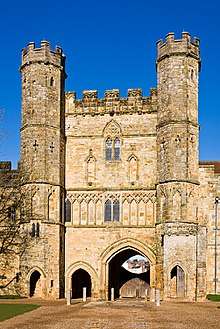
The Grade I listed site is now operated by English Heritage as 1066 Battle of Hastings, Abbey and Battlefield, which includes the abbey buildings and ruins, a visitor centre with a film and exhibition about the battle, audio tours of the battlefield site, and the monks' gatehouse with recovered artefacts. The visitor centre includes a children's discovery room and a café, and there is an outdoor-themed playground.
History
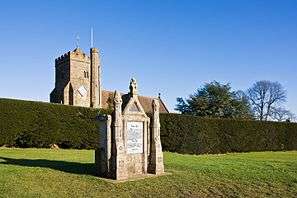 Battle Abbey – Norman monument to Harold
Battle Abbey – Norman monument to Harold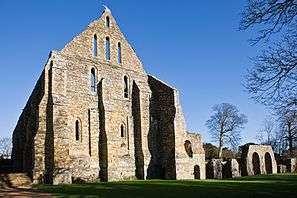 Battle Abbey – Dorter
Battle Abbey – Dorter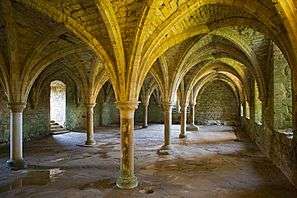 Battle Abbey – Novices Common Room
Battle Abbey – Novices Common Room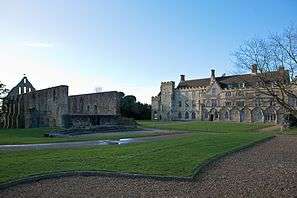 Battle Abbey – Dorter, remains of cloister and Battle Abbey School
Battle Abbey – Dorter, remains of cloister and Battle Abbey School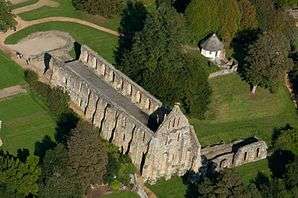 An aerial view of the Dorter
An aerial view of the Dorter
In 1070, Pope Alexander II ordered the Normans to do penance for killing so many people during their conquest of England. In response, William the Conqueror vowed to build an abbey where the Battle of Hastings had taken place, with the high altar of its church on the supposed spot where King Harold fell in that battle on Saturday, 14 October 1066. William started building it, dedicating it to St. Martin, sometimes known as "the Apostle of the Gauls," but died before it was completed. The Vill survey of 1076 and early legal documents of adjoining property refer to a hospital or guesthouse which was attached to the gate of the abbey.[2] Its church was finished in about 1094 and consecrated during the reign of his son William known as Rufus. William I had ruled that the church of St Martin of Battle was to be exempted from all episcopal jurisdiction, putting it on the level of Canterbury. Walter de Luci became abbot in 1139 and made several improvements. During the reign of Henry II of England rival church authorities at Canterbury and Chichester unsuccessfully tested the charter.[3] The church was remodelled in the late 13th century but virtually destroyed during the Dissolution of the Monasteries in 1538 under King Henry VIII.
At the dissolution, the displaced monks of Battle Abbey were provided with pensions, including the abbot John Hamond and the prior Richard Salesherst, as well as monks John Henfelde, William Ambrose, Thomas Bede and Thomas Levett, all bachelors in theology.
The abbey and much of its land was given by Henry VIII to his friend and Master of the Horse, Sir Anthony Browne, who demolished the church and parts of the cloister and turned the abbot's quarters into a country house.
It was sold in 1721 by Browne's descendant, Anthony Browne, 6th Earl of Montagu, to Sir Thomas Webster, MP and baronet. Sir Thomas had married the heiress Jane Cheek, granddaughter of a wealthy merchant, Henry Whistler, to whose vast inheritance she succeeded in 1719. Webster was succeeded by his son, Sir Whistler Webster, 2nd Baronet, who died childless in 1779, being succeeded in the baronetcy by his brother. Battle Abbey remained in the Webster family until 1857, when it was sold to Lord Harry Vane, later Duke of Cleveland. On the death of the Duchess of Cleveland in 1901, the estate was bought back by Sir Augustus Webster, 7th baronet.[4]
Sir Augustus (son of Sir Augustus, 7th baronet) was born in 1864 and succeeded his father as 8th baronet in 1886. In 1895, he married the only daughter of Henry Crossley of Aldborough Hall, Bedale. Sir Augustus was formerly a captain in the Coldstream Guards. The descendants of Sir Augustus Webster, 8th baronet (died 1923) who brought the extinction, finally sold Battle Abbey to the British government in 1976 and it is now in the care of English Heritage.[1]
It was an all-girls boarding school when Canadian troops were stationed there in the Second World War, and continues as a school now.
All that is left of the abbey church itself today is its outline on the ground, but parts of some of the abbey's buildings are still standing: those built between the 13th and 16th century. These are still in use as the independent Battle Abbey School.[5] Visitors to the abbey usually are not allowed inside the school buildings, although during the school's summer holidays, access to the abbot's hall is often allowed.
The church's high altar reputedly stood on the spot where Harold died. This is now marked by a plaque on the ground, and nearby is a monument to Harold erected by the people of Normandy in 1903. The ruins of the abbey, with the adjacent battlefield, are a popular tourist attraction, with events such as the Battle of Hastings reenactments.
In 2016, Historic England commissioned tree-ring analysis of oak timbers from the gatehouse, dorter and reredorte to help identify when these areas might have been built. Findings imply phased building and local timber acquisition, with samples indicating early and later fifteenth century building work.[1]
Interesting Facts
The appearance of Halley's Comet in 1066 was considered to be an important omen. The Bayeux Tapestry shows the audience witnessing Harold's coronation while watching Halley's Comet, which is depicted in the sky as an omen of Harold's fate.[6]
Burials
See also
- Abbot of Battle, a list of abbots of Battle Abbey
- Battle Abbey Roll
- List of monastic houses in East Sussex
- Senlac Hill
- Odo of Canterbury
The main building housing one of the largest paintings in England is now also currently a school and has been for the past 100 years as of 2016 .
References
- Arnold, Howard, Tyers, (2016). "Battle Abbey, Battle, East Sussex: Tree-Ring Analysis of Oak Timbers from the Gatehouse, Dorter and Reredorter. Historic England Research Report 58/2016". research.historicengland.org.uk. Retrieved 29 May 2020.CS1 maint: extra punctuation (link) CS1 maint: multiple names: authors list (link)
- "Hospitals: Battle." A History of the County of Sussex: Volume 2. Ed. William Page. London: Victoria County History, 1973. 98. British History Online Retrieved 24 June 2019.
- "Houses of Benedictine monks: Abbey of Battle." A History of the County of Sussex: Volume 2. Ed. William Page. London: Victoria County History, 1973. 52–56. British History Online Retrieved 24 June 2019.
- "History of Battle Abbey and Battlefield". English Heritage. Retrieved 9 November 2018.
- "Battle Abbey". Records of Early English Drama. University of Toronto. 2016. Archived from the original on 29 May 2017. Retrieved 8 November 2016.
- "8 Things You Didn't Know About 1066". English Heritage.
Further reading
- Austin, Nick (2012). Secrets of the Norman Invasion. ISBN 978-0954480165.CS1 maint: ref=harv (link)
- "1066 Battle of Hastings, Abbey and Battlefield". English Heritage. Retrieved 1 October 2016.
- Hare, J. N. (1985). Battle Abbey: The Eastern Range and the Excavations of 1978–80. English Heritage. ISBN 978-1850740629.CS1 maint: ref=harv (link)
- Historic England. "Battle Abbey (414519)". PastScape. Retrieved 1 October 2016.
- Page, William, ed. (1907) [1973]. Houses of Benedictine Monks: Abbey of Battle. A History of the County of Sussex. 2. London: Victoria County History. pp. 52–56. ISBN 978-0712905862.
External links
- White, Tim (2015). "The White Family of Battle". Archived from the original on 25 March 2010. Retrieved 1 October 2016.
- "Battle Abbey School". Retrieved 1 October 2016.
| Wikimedia Commons has media related to Battle Abbey. |